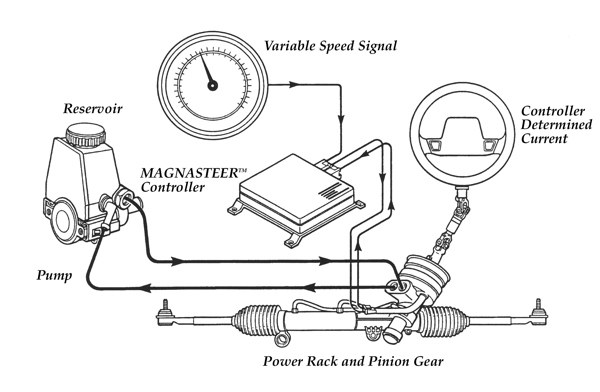Last Updated on January 29, 2024 by Pittalks
Variable Assist Power Steering is a feature that has been researched and engineered for the last two decades. It is a perfect blend of old and new technology that can help to make the engine more efficient. This technology has been employed on numerous vehicles, but it is essential to know how to tell if a vehicle has variable-assist power steering.
In 1951, Chrysler was the first to invent power-assisted steering, and soon other manufacturers adopted this technology. Currently, the presence of a variable-assist power steering in a vehicle can be determined by following a few steps. These steps include checking the vehicle specification list, the VIN, the label for the code NV7, and under the glove handle cover for a code that has an NV7 mark on it. Additionally, some vehicles feature warning lights that show power steering system problems.
Look up your car serial number at the dealer.
To find out the unique serial number for your vehicle, you can look it up at your local dealership. This number often indicates the sequence in which a vehicle came off of the assembly line. Since there is no fixed standard for this number, each manufacturer can use it differently. You can also check the vehicle specifications from the seller or online over a specific website to ensure that you have the correct information. It is important not to get confused between vehicle specification and variable ratio when analyzing the type of power steering system present in your vehicle.
Look at your Service Parts Identification label.
To determine if your car has variable-assist power steering, you can check the Service Parts Identification label located on the underside of the spare tire cover. If the code NV7 is present, then your car is equipped with variable-assist power steering. The NV7 code is built into the steering rack, so you won’t see a separate component.
It’s important to note that the Service Parts Identification label is different from the Build Tag. The Build Tag can also be found under the lid of the trunk and may contain the code 1SC, indicating that your car has GM variable-assist power steering.
By checking both the Service Parts Identification label and the Build Tag, you can confirm if your car has variable-assist power steering and ensure that it is still functional.
Understand your kind of power steering system
If you own a vehicle with a power steering system, it’s important to understand the type of system you have. There are two common types of power steering systems: hydraulic assist and electric assist. However, the most efficient technology used in vehicles is variable-assist power steering. In this section, we will discuss how variable-assist power steering works and the difference between active steering and variable-assist steering. We will also clarify whether the variable ratio is different from the assist steering.
Related Questions
How does variable-assist power steering work?
Variable-assist power steering works by regulating the pressure of the steering gear. The system utilizes sensors to track the speed and rotation of the car’s wheels, which then send signals to the control unit. The control unit regulates the pressure, reducing the flow of fluid into the steering gear system. This results in a stable and controlled vehicle, especially at high speeds.
The variable-assist steering actuator pumps up the fluid to the steering valve, which controls the rack piston mechanism responsible for steering the car. The Electronic Variable Orifice (EVO) is another crucial component in the variable-assist system. At speeds below 40 MPH, the EVO opens up, allowing maximum power to pump up the hydraulic fluid from the power steering to the steering unit. When the speed exceeds its limit, a specially designed control module stimulates the EVO to restrict the flow of the hydraulic fluid. Therefore, the intelligent mechanism of reduced assist enhances stability.
Diagnosing the mechanism
The advanced system utilizes the vehicle’s speed and pressure to assist the steering at varied speed (as high as running through a highway or as low as while parking a car).
A specially designed system controller keeps track of the sensors’ speed and pressure-related data. To pump up the fluid to the steering valve, the system controller indicates the variable-assist steering actuator.
This particular action impacts the pressure exerted on the steering valve. As we already know, the steering valve is responsible for controlling the rack piston mechanism. The rack piston is responsible for altering the anterior portion of the vehicle wheels and is required to steer the car.
Electronic Variable Orifice or the EVO
Electronic Variable Orifice or the EVO is one of the most crucial components in the variable-assist system. At speed below 40 MPH, the EVO opens up, enabling maximum power to pump up the hydraulic fluid from the power steering to the steering unit.
Now when the speed exceeds its limit, a specially designed control module stimulates the EVO to restrict the flow of the hydraulic fluid.
Therefore, the intelligent mechanism of reduced assist enhances stability. The variable-assist power steering also ensures lesser risk by providing better control at such a high speed.
To ensure better functioning of the variable-assist power steering, the EVO valve, control module and vehicle speed sensors must be in good working condition.
In the worst-case, if any of these components does not work accurately, the regulated assist mechanism will not work. As a consequence, the vehicle will even lose the power assist steering ability.
Variable assist power steering system is an incredible technology and one of the most reliable options. However, the only drawback is that it may start wearing down after using it for a long time. Once it starts to wear down, it may end up passing out wrong signals to the control unit.
Active steering vs Variable assist steering
Active steering and variable-assist steering are two different technologies used in vehicles. Active steering controls the driver’s steer information with steer angle, reducing the power electric variable gear ratio to turn the steering wheel at minimum speed. This decrease in ratio enhances performance while parking or driving at low speeds. The technology ensures stability and avoids speed jerks at higher speeds.
On the other hand, the mechanism of variable-assist steering is a blend of fingertip parking at lower speeds and reduced assistance at higher speeds. The technology ensures a smoother feel and higher stability.
Is the variable ratio different assist steering ?
Yes, the variable ratio is not similar to assist steering. The electronically controlled variable gear ratio adjusts to the ideal steering condition irrespective of the car’s speed. This variable ratio adjusts the shape of the teeth on the frame. When space reduces, the teeth at the rack’s center move up, and the intermediate space increases as the pinion moves down the rack. Therefore, the variable steering ratio mechanism can only be beneficial only if assist steering accompanies it.
It’s important to note that the variable-assist power steering system is one of the most efficient technologies used in vehicles. However, the system may start wearing down after using it for a long time. Once it starts to wear down, it may end up passing out wrong signals to the control unit. Therefore, to ensure better functioning of the variable-assist power steering, the EVO valve, control module, and vehicle speed sensors must be in good working condition. If any of these components does not work accurately, the regulated assist mechanism will not work, and the vehicle will even lose the power assist steering ability.
In conclusion, understanding your power steering system is crucial to ensure your vehicle’s safety and performance. Knowing how your variable-assist power steering system works and the difference between active steering and variable-assist steering can help you make informed decisions about your vehicle’s maintenance and repairs.
Frequently Asked Questions
The most noticeable sign of a variable assist power steering system in operation is the change in steering effort based on the vehicle’s speed. At low speeds, the system provides maximum power assist, while at higher speeds, the system reduces the amount of assistance to improve stability and control.
Standard power steering systems provide a consistent level of power assist regardless of the vehicle’s speed, while variable assist power steering systems adjust the level of assistance based on the vehicle’s speed. This results in lighter steering effort at low speeds and reduced assistance at higher speeds for improved stability and control.
Some common symptoms of a failing variable assist power steering mechanism include difficulty turning the steering wheel, a whining or groaning noise when turning the wheel, and a loss of power assist at low speeds.
Variable assist power steering improves the driving experience by providing lighter steering effort at low speeds for easier maneuvering and tighter turns, while reducing assistance at higher speeds for improved stability and control. This results in a more comfortable and responsive driving experience compared to traditional power steering systems.

